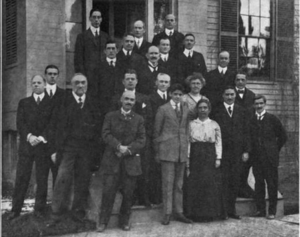American Association of Variable Star Observers facts for kids
The American Association of Variable Star Observers (AAVSO) is an international group that doesn't make a profit. It was started in 1911. This organization helps gather, study, and share information about variable stars. Most of the observations come from people who enjoy amateur astronomy as a hobby.
AAVSO creates special charts called light curves. These charts show how a star's brightness changes over time. This information is very helpful for professional astronomers, scientists, and teachers. Since professional astronomers can't watch every single variable star, people who do astronomy as a hobby (called citizen scientists) play a huge role. They make important discoveries!
In 2011, when AAVSO turned 100 years old, they received their 20 millionth observation. By 2019, their database, called the AAVSO International Database (AID), had over 35 million observations. Each year, about 2,000 professional and amateur observers send in almost 1,000,000 new observations. Scientists often use AAVSO's data in their research papers. AAVSO also manages a website called the International Variable Star Index (VSX), which lists over 2.2 million variable stars.
AAVSO is also very active in teaching and reaching out to the public. They often hold workshops to train citizen scientists. They even publish scientific papers where hobby astronomers are listed as co-authors. In the 1990s, AAVSO created a learning program called Hands-On Astrophysics, which is now known as Variable Star Astronomy. The National Science Foundation (NSF) helped support this program. In 2009, AAVSO received a large grant from the NSF to run a project called Citizen Sky. This project was a team effort between professionals and amateurs to study the eclipse of the star epsilon Aurigae from 2009 to 2011.
The first home of AAVSO was at the house of its founder, William Tyler Olcott, in Norwich, Connecticut. A small planet, Minor Planet (8900) AAVSO, is even named after the organization!
Contents
AAVSO's Journey Through Time
After AAVSO officially became an organization in 1918, it unofficially moved to Harvard College Observatory. This observatory later became AAVSO's official headquarters from 1931 to 1953. After that, AAVSO moved to different places around Cambridge. In 1985, they bought their first own building, which they called the Clinton B. Ford Astronomical Data and Research Center. In 2007, AAVSO bought and moved into the building that used to belong to Sky & Telescope magazine.
As of September 16, 2022, Brian Kloppenborg became the Executive Director of AAVSO. Before him, Kathy Spirer held the role for nine months. Styliani ("Stella") Kafka was the director from February 2015 until late 2021. She took over from Arne Henden. For many years before that, Janet Mattei was the director of AAVSO. She passed away in March 2004.

People Who Led AAVSO
Over the years, many dedicated people have helped lead AAVSO.
Directors of AAVSO
- William T. Olcott (1911–1918, Founder)
- Janet A. Mattei (AAVSO Director 1973–2003)
- Arne Henden (2005–2015)
- Styliani ("Stella") Kafka (2015–2021)
- Brian Kloppenborg (2022–)
Presidents of AAVSO
- David B. Pickering (1917–1918, 1927–1929)
- Anne S. Young (1922–1924)
- Harlow Shapley (1935–1937)
- Helen S. Hogg (1939–1941)
- E. Dorrit Hoffleit (1961–1963)
- John R. Percy (1989–1991)
- Paula Szkody (2007–2009)
- David Cowall (2021–2024)
Other Important Members
AAVSO has over 2,000 members and observers today, with about half of them living outside the United States. Many of these members have made important contributions to astronomy.
- Leah B. Allen
- Clinton B. Ford
- Pamela L. Gay
- Carolyn Hurless
- Leslie Peltier
- Ida E. Woods
See also
 In Spanish: American Association of Variable Star Observers para niños
In Spanish: American Association of Variable Star Observers para niños
- List of astronomical societies

